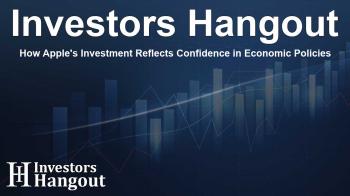How Apple's Investment Reflects Confidence in Economic Policies

Apple's Landmark Investment in the U.S.
Recently, President Donald Trump highlighted the remarkable $500 billion investment that Apple Inc (NASDAQ: AAPL) is set to make in the United States. This massive commitment marks a significant chapter in Apple's history and underlines the company's strong sense of belief in U.S. economic growth and innovation.
What Led to This Investment?
On a post shared via his Truth Social platform, Trump celebrated Apple's decision, emphasizing that it demonstrates the company's confidence in his administration's policies. He pointed out, "Without which, they wouldn't be investing ten cents," framing the investment as a strong endorsement of his economic strategies.
The Nature of the Investment
Apple’s announcement includes a pledge to invest over $500 billion across the next four years. This significant financial commitment will not only enhance Apple’s existing operations but also generate an estimated 20,000 new jobs within the country. The impact of such an investment cannot be overstated, particularly in the context of stimulating the U.S. economy.
The Vision for American Innovation
Tim Cook, the CEO of Apple, shared his thoughts on this bold investment. He stated, “We are bullish on the future of American innovation,” reflecting the company’s long-term commitment to the tech landscape in the U.S. This investment represents a continuation of Apple's decade-long practice of investing in American jobs and infrastructure.
Infrastructure Development
As part of this monumental investment, Apple has plans to construct a state-of-the-art manufacturing facility in Houston, Texas. This facility will be integral to producing servers for Apple Intelligence, a platform aimed at enhancing user experience across various tasks and services.
Expanding Manufacturing Efforts
In addition to the Houston facility, Apple will also broaden its U.S. Advanced Manufacturing Fund, indicating its intent to bolster manufacturing capabilities within the U.S. Furthermore, the company has committed to establishing a training academy in Michigan, with the goal of nurturing talent and expertise in advanced manufacturing technologies.
Responses from Leadership
The announcement of this investment comes on the heels of a recent meeting between Tim Cook and President Trump. During their conversation, Cook assured Trump that Apple would be shifting much of its manufacturing operations from Mexico back to the U.S. This move signifies a concrete effort to align manufacturing strategies with current economic policies.
Implications of the Investment
This ambitious initiative from Apple also aims to mitigate potential tariffs that the company might face. After discussing the investment with executives, Trump remarked on the importance of building in the U.S., reinforcing the idea that factories should be located on American soil to avoid tariff implications.
Historical Context
Historically, Apple has made various commitments during previous administrations to invest in American manufacturing. Their ongoing evolution highlights a consistent narrative of growth and development aimed at enhancing U.S. competitiveness in technology and innovation.
Looking Ahead
Financial analyses have indicated that if tariffs were implemented as a result of trade policies, Apple might have to consider increasing prices on its flagship products. Yet, by investing heavily in domestic manufacturing, Apple is strategically positioning itself to remain competitive while supporting the U.S. economy.
Conclusion
In conclusion, Apple's historic $500 billion investment marks not just a milestone for the company, but also a pivotal moment for American manufacturing and innovation. As Apple Inc continues on this trajectory, it reinforces the narrative that investment in the U.S. can generate economic growth and job creation, aligning corporate strategies with national interests.
Frequently Asked Questions
What is the significance of Apple's $500 billion investment?
The investment underscores Apple's commitment to U.S. innovation and job creation while demonstrating confidence in current economic policies.
Where will the new manufacturing facility be located?
The new state-of-the-art manufacturing facility will be established in Houston, Texas, to support Apple's growing technology needs.
How many jobs will Apple create with this investment?
Apple's investment is expected to generate approximately 20,000 new jobs throughout the U.S.
What are Apple's plans for expanding its manufacturing?
Apple plans to expand its U.S. Advanced Manufacturing Fund and establish a new training academy in Michigan.
How does this investment relate to tariffs?
The investment is partly a strategic move to avoid potential tariffs by relocating manufacturing back to the U.S.
About The Author
Contact Owen Jenkins privately here. Or send an email with ATTN: Owen Jenkins as the subject to contact@investorshangout.com.
About Investors Hangout
Investors Hangout is a leading online stock forum for financial discussion and learning, offering a wide range of free tools and resources. It draws in traders of all levels, who exchange market knowledge, investigate trading tactics, and keep an eye on industry developments in real time. Featuring financial articles, stock message boards, quotes, charts, company profiles, and live news updates. Through cooperative learning and a wealth of informational resources, it helps users from novices creating their first portfolios to experts honing their techniques. Join Investors Hangout today: https://investorshangout.com/
The content of this article is based on factual, publicly available information and does not represent legal, financial, or investment advice. Investors Hangout does not offer financial advice, and the author is not a licensed financial advisor. Consult a qualified advisor before making any financial or investment decisions based on this article. This article should not be considered advice to purchase, sell, or hold any securities or other investments. If any of the material provided here is inaccurate, please contact us for corrections.

